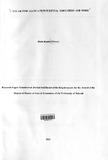| dc.description.abstract | This paper examines the factors that determine youth participation in either work or schooling or work and schooling or none of the two activities in Kenya. A multinomial logit model was specified and then estimated using data drawn from the 2005/2006 Kenya Integrated Household Budget Survey. The factors examined include youth's characteristics, parental and household characteristics and area characteristics.
It was found that area of residence, gender, marital status, household headship and parental education influence the youth's participation in education and work. Young men are more likely to participate than young women in education and work related opportunities. Married youth are more likely to be working and less likely to be in school or combining both school and work.
Parental education increases the chances of youth schooling and reduces the probability of youths working. Results from different regions show that the extent of youth combining work and schooling differ from one region to another. Therefore the government can use these results to formulate policies which can best fit the unique conditions of the youth in the country. This will also address labour force challenges which are region specific affecting the youth. This paper has extended the existing literature on youth labour participation by examining youth schooling and work jointly in Kenya. | en_US |

